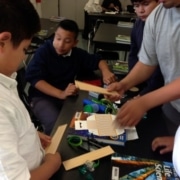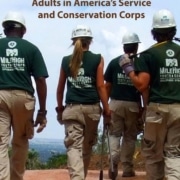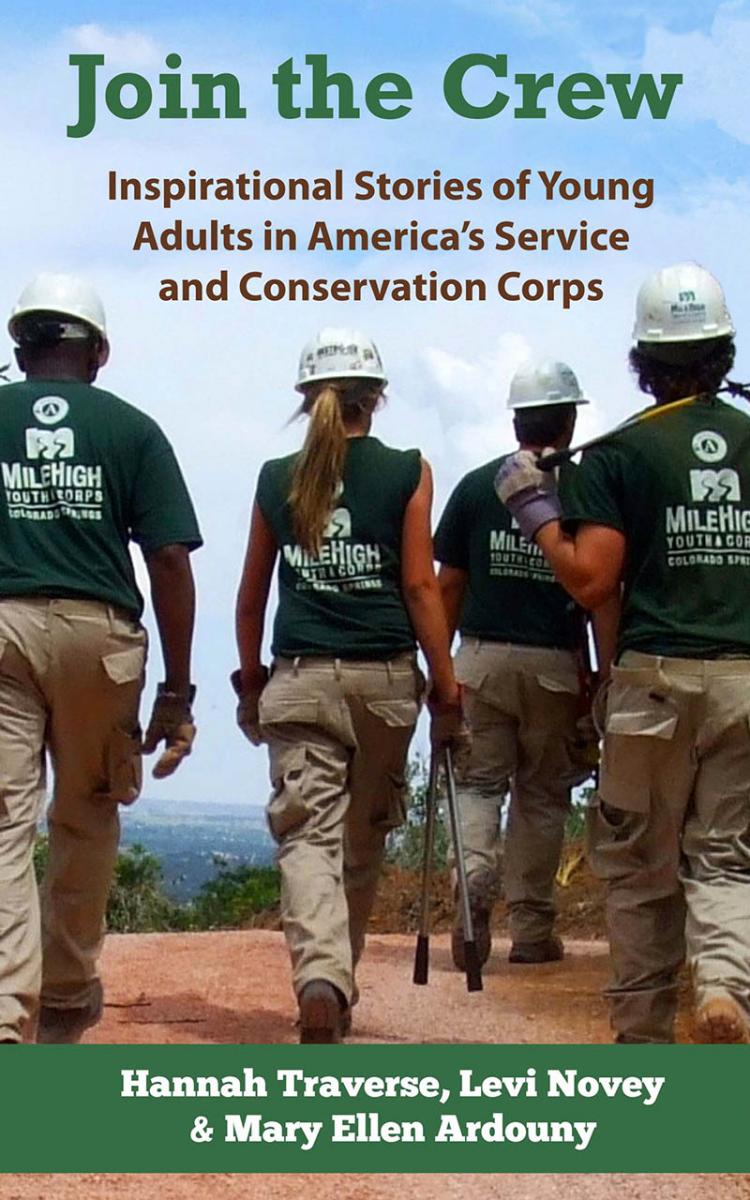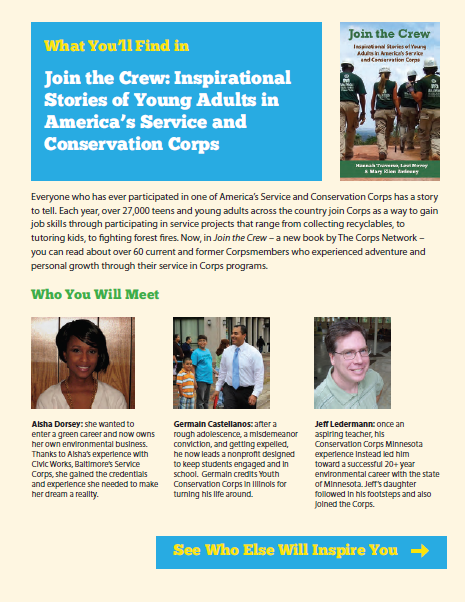Montana Conservation Corps helps build “Vigilante Bike Park”

Taken from the Helena Independent Record
By Al Knauber, PHOTOS by Eliza Wiley, Independent Record
More than a year’s worth of planning became a reality in about five hours of work.
The Montana Conservation Corps, which has helped build trails across the state, wanted to do a project with greater visibility and enlisted the aid of Carroll College students in late September. The group assembled at Helena’s Centennial Park for the 20th anniversary of National Public Lands Day.
With shovels and sweat, they and other volunteers, numbering 112 in all, created Vigilante Bike Park, Helena’s bike park.
T&E The Cat Rental Store provided a “skid-steer,” a small piece of machinery that’s been compared to a mini-bulldozer, that Joe Robbins drove that day. Chris Charlton of Jefferson City brought one too and helped move dirt for the first track at the bike park, said Will Harmon, who has long wanted to see a bike park in Helena and participated in the effort to make it a reality.
Only a small portion of the 3.9 acres set aside for bicycling at Centennial Park was used to build this first track.
By the end of that day, a rider gave the track a test drive. It passed the test.
The track isn’t just for mountain bikes; it is designed for those who relish the chance to jump and flip and twist on smaller BMX bikes.
Amy Teegarden, Helena’s parks and recreation director, said she’s heard the track has been called “sick,” a designation that pleases her.
In the vernacular of those who ride, she explained, this is a compliment.
The first track is what’s called a “pump track” and relies on a rider’s initial momentum and the spacing between rises and dips in the track and berms instead of pedaling to keep a rider speeding along.
Riders push down on their handlebars and pedals as they descend from each rise on the track to accelerate and then rise up from that squat position as the bike crests the next hill. The result of this physical workout converts gravitational force into speed.
But that’s the scientific explanation for what riders say is fun.

“It’s like a mini-roller coaster for bikes,” Harmon said.
“It’s like the craziest mountain biking you’ve ever been through, but it’s condensed into a 300 foot loop,” he added.
Get him talking about the course and the excitement is evident in his voice. Harmon is an avid bicyclist himself, as are his two sons, and he has bicycles specially designed for the type of riding he will do. One of them is intended to be taken to the top of ski slopes in the summer and ridden to the bottom. He grins when he explains this. His trio of bicycles, he said, is worth more than his car.
This first pump track is one of three that will be built, say Harmon and Pat Doyle, the Helena Tourism Alliance’s community outreach director. One of the other two pump tracks will be less challenging and intended more for children who are just beginning to develop their bicycling skills. The third pump track will be more advanced and have more of those features that BMX riders want to see.
Having a bike park that is appealing to BMX riders is important.
Centennial Park was built atop a former city landfill. A few feet beneath the surface is a liner that keeps snowmelt and rain from leeching contaminants out of the buried garbage. As plans were made for how to convert the site into a recreational attraction, an area for BMX riders was proposed, Teegarden said.
However, in the five years that she’s been the parks director, that focus has shifted to mountain biking.
Despite that shift, providing for BMX riders has remained important because without a place to practice, these riders have been using the skate park as a place to ride.
The skate park, however, wasn’t built for multiple use, Teegarden said.
The bike park isn’t intended to be just a place to ride, said Doyle, but a place for people “to get more comfortable on mountain bikes before they go out on trails.”
A skills track is planned for the bike park that will also allow riders to traverse a portion of city history. Granite slabs salvaged as old buildings were demolished in the 1970s during the urban renewal movement will be incorporated into this design.
“We’ve incorporated it into various parks including the walking mall,” Teegarden said of the granite slabs.
Bike park features are being designed by the city with suggestions from those who ride mountain bikes, Harmon said. Industry standards for bike park features are being used in the design.
“One of the really unique things about this process is that it’s on city land,” Doyle said.
Other communities, he explained, have struggled to find locations for their bike parks. Doyle predicts communities will see the value of bike parks and embrace them in the coming years even if for now it has yet to blossom as an accepted urban recreation.
“It’s a very proactive thing for the city to do,” he added.
Some 2,000 cubic yards of dirt will be needed to make the entire park a reality, as will about $180,000.
The installation of the first pump track cost about $5,000. This is less than was anticipated because of the volunteer labor, Teegarden said.
The city contributed land for the bike park and some $20,000.
Doyle and Harmon say they see a return on the community investment in a bike park.
Having the first track in place at the bike park gives people more of an idea of what the facility will offer, Doyle said, and will help with fundraising.
He said he sees the bike park as a tourism attraction and said, “This bike park will be the first of its kind in the state.”
“People are always looking for other places to ride,” he continued. “Helena is already an incredible place to ride.”
“Right now, it’s a little bit of an underground tourism niche,” Harmon said of those who seek out bike parks.
But he, too, sees the potential.
“The people who do this stuff aren’t shy about spending money on their sport,” Harmon said. “And they travel.”
Centennial Park has become more than a showcase for urban recreation. The area set aside for dogs to run off-leash was made possible by donations as was the installation of a roughly 11-foot-tall climbing boulder. Making the bike park a reality will rely on the same sorts of community support.
Donations are being accepted by the Helena Recreation Foundation, which has a nonprofit tax status allowing for tax-deductible donations to be made to the bike park, Doyle said.
Harmon looks for the first two phases of construction to be completed in about a year from now. He and Doyle say they appreciate the city’s efforts to make the bike park a reality.
“We can’t thank Craig (Marr, Helena’s parks’ superintendent) and Amy enough. They’ve been tremendous,” Harmon said, adding, “The city is lucky to have them, not just as employees, but as people with vision and insight.”






















































































